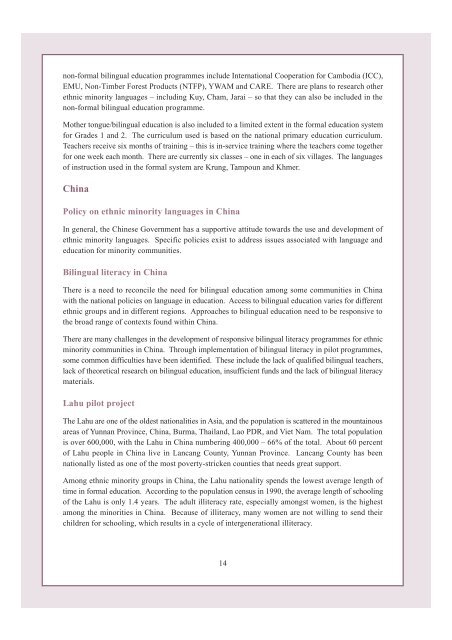Part I.pdf - MTB-MLE Network
Part I.pdf - MTB-MLE Network
Part I.pdf - MTB-MLE Network
You also want an ePaper? Increase the reach of your titles
YUMPU automatically turns print PDFs into web optimized ePapers that Google loves.
non-formal bilingual education programmes include International Cooperation for Cambodia (ICC),EMU, Non-Timber Forest Products (NTFP), YWAM and CARE. There are plans to research otherethnic minority languages – including Kuy, Cham, Jarai – so that they can also be included in thenon-formal bilingual education programme.Mother tongue/bilingual education is also included to a limited extent in the formal education systemfor Grades 1 and 2. The curriculum used is based on the national primary education curriculum.Teachers receive six months of training – this is in-service training where the teachers come togetherfor one week each month. There are currently six classes – one in each of six villages. The languagesof instruction used in the formal system are Krung, Tampoun and Khmer.ChinaPolicy on ethnic minority languages in ChinaIn general, the Chinese Government has a supportive attitude towards the use and development ofethnic minority languages. Specific policies exist to address issues associated with language andeducation for minority communities.Bilingual literacy in ChinaThere is a need to reconcile the need for bilingual education among some communities in Chinawith the national policies on language in education. Access to bilingual education varies for differentethnic groups and in different regions. Approaches to bilingual education need to be responsive tothe broad range of contexts found within China.There are many challenges in the development of responsive bilingual literacy programmes for ethnicminority communities in China. Through implementation of bilingual literacy in pilot programmes,some common difficulties have been identified. These include the lack of qualified bilingual teachers,lack of theoretical research on bilingual education, insufficient funds and the lack of bilingual literacymaterials.Lahu pilot projectThe Lahu are one of the oldest nationalities in Asia, and the population is scattered in the mountainousareas of Yunnan Province, China, Burma, Thailand, Lao PDR, and Viet Nam. The total populationis over 600,000, with the Lahu in China numbering 400,000 – 66% of the total. About 60 percentof Lahu people in China live in Lancang County, Yunnan Province. Lancang County has beennationally listed as one of the most poverty-stricken counties that needs great support.Among ethnic minority groups in China, the Lahu nationality spends the lowest average length oftime in formal education. According to the population census in 1990, the average length of schoolingof the Lahu is only 1.4 years. The adult illiteracy rate, especially amongst women, is the highestamong the minorities in China. Because of illiteracy, many women are not willing to send theirchildren for schooling, which results in a cycle of intergenerational illiteracy.14
















